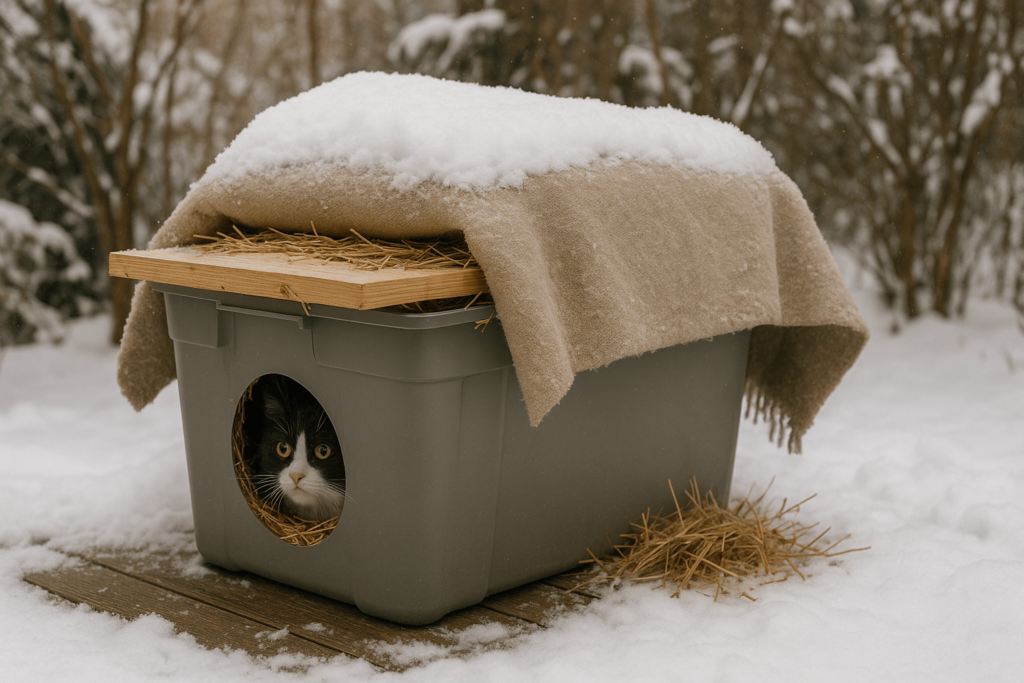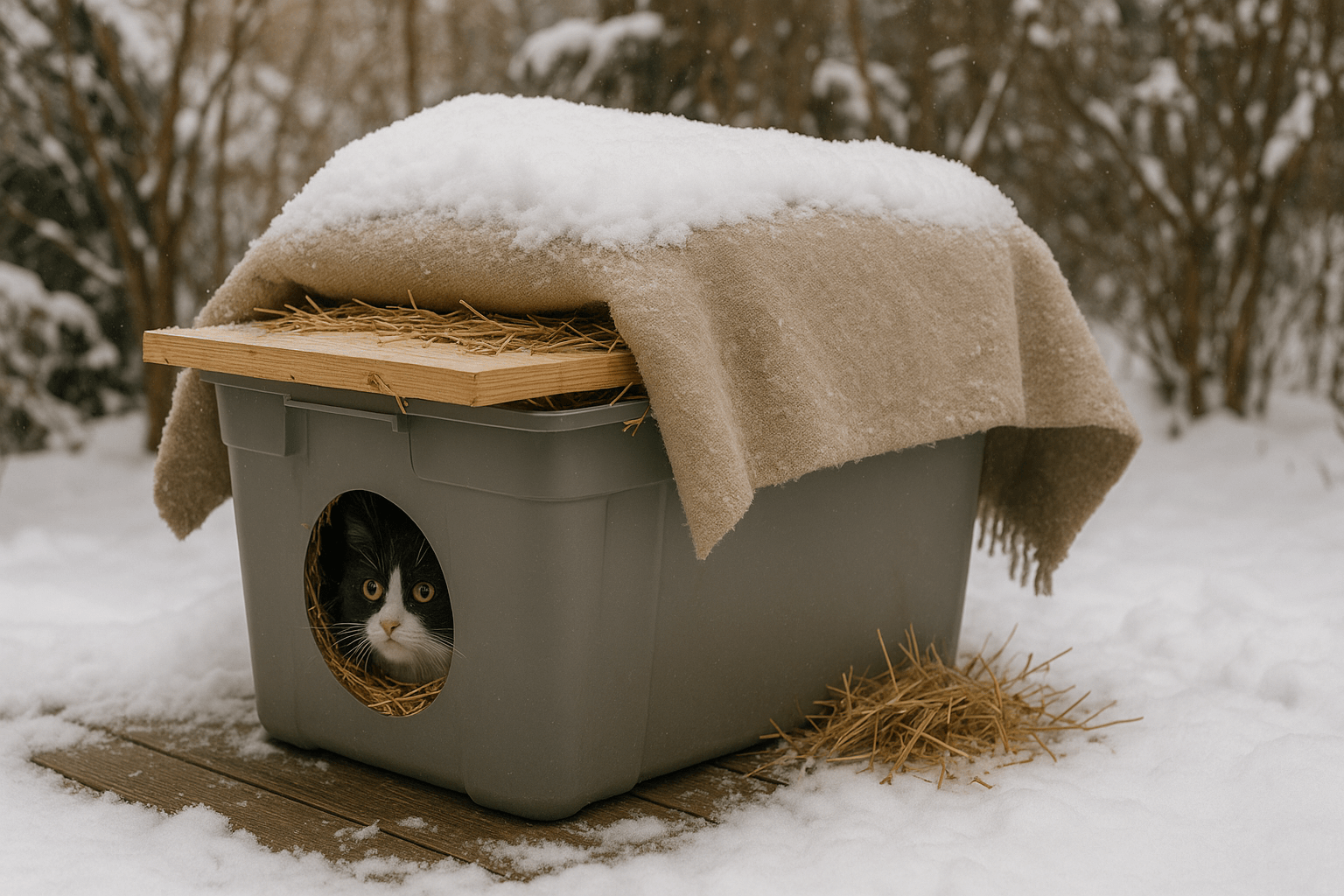DIY Cat Winter Shelter: Keeping Outdoor Cats Safe and Warm
As temperatures drop during the winter months, outdoor cats face harsh conditions that can threaten their health and well-being. Providing a DIY cat winter shelter is a compassionate and practical way to ensure these feline friends have a safe, warm refuge from the cold. Whether you’re caring for a community of stray cats or simply want to help neighborhood kitties, building a winter shelter is easier than you might think. With some basic materials and a little creativity, you can create a cozy haven that protects cats from freezing temperatures, wind, and snow. Let’s explore how you can make a difference this winter by crafting your own DIY cat winter shelter.
Essential Materials for Building a DIY Cat Winter Shelter
Creating a functional and durable winter shelter doesn’t require expensive tools or materials. Here’s a list of essential items you’ll need to get started.
Plastic Storage Bin:
A large, sturdy plastic bin serves as the main structure of the shelter. Look for one with a tight-fitting lid to keep out moisture.Insulating Material:
Use straw (not hay) as insulation—it’s excellent at retaining heat and staying dry. Avoid blankets or towels, which can retain moisture.Foam Board or Reflective Insulation:
Line the interior walls with foam board or reflective insulation to add an extra layer of warmth.Waterproof Tape:
Seal any gaps or edges with waterproof tape to prevent drafts and water leaks.Heating Pad (Optional):
For extreme climates, consider adding a heated pet bed or microwavable heating pad designed for pets.
With these materials in hand, you’ll be well-prepared to construct a shelter that keeps outdoor cats snug and secure throughout the winter.

Step-by-Step Guide to Building Your DIY Cat Winter Shelter
Building a winter shelter is a straightforward process that anyone can tackle. Follow these steps to create a safe and inviting space for outdoor cats.
Choose the Right Location:
Place the shelter in a quiet, sheltered area away from direct wind and heavy foot traffic. Ensure it’s easily accessible for cats.Cut an Entrance Hole:
Use a utility knife to cut a small entrance hole (6-8 inches wide) on one side of the bin. The opening should be just large enough for cats to enter comfortably.Add Insulation Layers:
Line the bottom of the bin with straw and attach foam board or reflective insulation to the interior walls for added warmth.Create a Lid Cover:
Cut a second, slightly smaller hole in the lid of the bin and place it upside-down over the entrance to act as a protective awning.Secure the Shelter:
Weigh down the shelter with bricks or rocks to prevent it from tipping over in strong winds.
By following these steps, you can build a durable and effective winter shelter that provides outdoor cats with much-needed protection during colder months.
Check this guide 👉How Long Does a Cat Cold Last? Best 7 Expert Tips!
Check this guide 👉Can a Cat Die from a Cold? Best 7 Expert Tips!
Check this guide 👉Why Are My Cats Ears Cold? Best 7 Expert Tips!
Pros of DIY Cat Winter Shelters | Tips for Maintenance |
|---|---|
Cost-effective compared to store-bought | Check weekly for damage or wear |
Customizable to fit specific needs | Replace straw regularly to keep it dry |
Easy to assemble with basic tools | Clear snow or ice from the entrance daily |
Eco-friendly use of recycled materials | Monitor for pests or rodents |
Provides immediate relief for stray cats | Move shelter if location becomes unsafe |
Additional Features to Enhance Your DIY Shelter
While a basic shelter is sufficient, adding a few extra features can make it even more comfortable and appealing for outdoor cats.
Camouflage Design:
Paint the exterior of the shelter with non-toxic paint to blend it into its surroundings, making it less noticeable to predators.Two Entrances:
Adding a second entrance allows cats to escape quickly if threatened by other animals or dangers.Raised Platform Base:
Elevate the shelter off the ground using wooden pallets or bricks to prevent moisture seepage and improve insulation.Reflective Tape or Markers:
Use reflective tape around the entrance to increase visibility at night, helping cats locate the shelter easily.Food and Water Station Nearby:
Set up a feeding station close to the shelter but not inside it to avoid attracting pests or creating messes.
These enhancements can significantly improve the functionality and appeal of your DIY cat winter shelter.
Common Mistakes to Avoid When Building a Shelter
Even with good intentions, mistakes in design or construction can compromise the effectiveness of your DIY cat winter shelter. Here’s what to watch out for.
Using Incorrect Insulation:
Avoid materials like blankets or fabric, as they can absorb moisture and freeze, making the shelter colder.Making the Entrance Too Large:
A wide entrance lets in too much cold air and may attract larger animals seeking shelter.Skipping Waterproofing Measures:
Failing to seal gaps or use waterproof materials can lead to leaks and dampness inside the shelter.Placing the Shelter in a Poor Location:
Avoid areas exposed to strong winds or flooding risks, as these can render the shelter useless.Neglecting Regular Cleaning:
Dirty or wet bedding can harbor bacteria and odors, deterring cats from using the shelter.
Avoiding these common pitfalls ensures your shelter remains safe, functional, and inviting for outdoor cats.
Tips for Attracting Cats to the Shelter
Once your DIY cat winter shelter is ready, you’ll want to encourage cats to start using it. These tips can help draw them in and make them feel welcome.
Sprinkle Catnip Inside:
Placing a small amount of catnip near the entrance can entice curious cats to investigate the shelter.Leave Familiar Scents:
Add a piece of unwashed clothing or fabric with a human scent to make the shelter feel safer for wary cats.Provide Food Nearby:
Setting up a feeding station close to the shelter helps build trust and encourages cats to associate the area with comfort.Ensure Privacy:
Position the shelter in a secluded spot where cats feel secure and protected from prying eyes.Be Patient:
It may take time for cats to adjust to the new shelter. Avoid forcing them to enter—let them explore at their own pace.
With patience and persistence, you can successfully attract cats to your DIY winter shelter.
How to Winterize Existing Outdoor Shelters
If you already have an outdoor shelter, there are ways to upgrade it for colder weather without starting from scratch. These modifications can boost its performance during winter.
Add Extra Insulation:
Layer additional straw or foam insulation inside the shelter to improve heat retention.Seal Gaps and Cracks:
Use weatherproof caulk or duct tape to seal any openings that could let in cold air or moisture.Install a Heated Bed:
Incorporate a low-wattage heated pet bed to provide consistent warmth without posing a fire hazard.Raise the Shelter Off the Ground:
Elevating the shelter prevents cold ground temperatures from transferring into the interior.Reinforce the Roof:
Strengthen the roof with additional waterproof material to prevent leaks during rain or snowfall.
Winterizing existing shelters ensures they remain effective and safe for outdoor cats throughout the season.
Community Efforts to Build Cat Shelters
Collaborating with others can amplify your impact and provide more resources for outdoor cats in need. Here’s how you can engage your community in building DIY cat winter shelters.
Host a Shelter-Building Workshop:
Organize a group event where participants learn to build shelters together, fostering teamwork and education.Partner with Local Businesses:
Reach out to hardware stores or pet supply shops for donations of materials like bins, straw, or insulation.Spread Awareness Through Flyers:
Distribute informational flyers to educate neighbors about the importance of winter shelters for stray cats.Create a Shared Maintenance Schedule:
Coordinate with volunteers to check and maintain shelters regularly, ensuring they remain in good condition.Fundraise for Supplies:
Start a small fundraiser to cover the cost of materials, especially if you plan to build multiple shelters.
Community involvement not only increases the number of shelters available but also strengthens bonds among animal lovers.
Frequently Asked Questions About DIY Cat Winter Shelters
How often should I check the shelter?
Inspect the shelter at least once a week to ensure it’s clean, dry, and free of damage.
What’s the best insulation to use?
Straw is ideal because it retains heat and resists moisture better than other materials.
Can I use a heated blanket inside the shelter?
Avoid electric blankets due to fire hazards; opt for microwavable heating pads or heated pet beds instead.
Where should I place the shelter?
Choose a quiet, sheltered spot away from strong winds, flooding risks, and high foot traffic.
How do I know if cats are using the shelter?
Look for signs like paw prints, fur, or disturbed bedding to confirm that cats are taking advantage of the space.
Making a Difference for Outdoor Cats This Winter
Building a DIY cat winter shelter is a simple yet impactful way to care for outdoor cats during the coldest months of the year. By providing a warm, dry refuge, you’re not only safeguarding their health but also showing compassion for vulnerable animals in your community. Whether you choose to build a single shelter or rally your neighbors to create a network of safe spaces, every effort counts. Remember, even small actions can make a big difference in the lives of stray and feral cats. So grab your tools, gather your materials, and get started—your kindness will be felt far beyond the frosty winter days.
Canned Pumpkin for Cat Diarrhea: Best 7 Expert Tips! Natural remedy to firm stools, soothe upset bellies, and support gut health safely.
Can a Cat Give You Scabies? Best 7 Expert Tips! Discover the truth about feline mites, human skin risks, and how to protect yourself—without panic.
Cat Flea vs Human Flea: Best 7 Expert Tips! Discover the truth about bites, species, and how to eliminate infestations for good.
Weird Cat Behaviors: Best 7 Expert Tips! Discover why cats do strange things—and how to understand, not punish, their instincts for a happier home.





